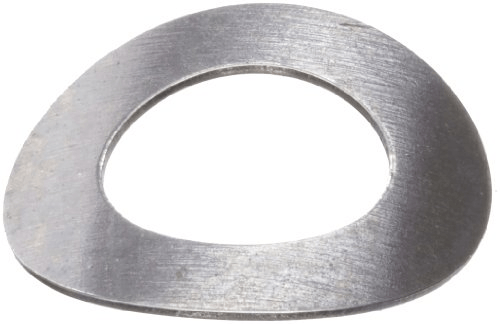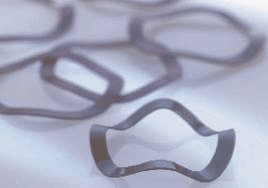

Spring washers, sometimes called disc springs, are a subtype of washers. They lend their mechanical capabilities to the unique profile of the material: when subject to a load, the irregularities of the washer compress with a proportionate resistance to return to their predeflected shape. Spring washers are employed in applications where assemblies need a part to take up play, eliminate rattle, maintain assembly tension, compensate for expansion or contraction in materials after assembly, or to absorb intermittent shock loads and provide a controlled reaction under dynamic loads.

Operation
Deflecting under a load, a spring washer is very much like a compression spring. As such, the deflection rate of a wave washer is conditional of the washer's dimensions and materials. Thicker, taller spring washers can sustain more load. When under stress, the raised irregularities of the disc spring flatten to a predetermined degree. Spring washers are either under static or dynamic load. In a static load application, the basic function of the washer is to retain load and the elastic load rating of the washer material may be exceeded. For a dynamic load, the washer functions as a flexing spring and the yield limit must not be exceeded or permanent disfiguration will occur.
Spring washers undergo elastic deformation which is reversible and is determined by the material of construction. If the washer is overstressed or near the end of its cycle life, it will experience plastic deformation where some of its deflection is irreversible; this is the first sign of washer fatigue.
Spring washers have a small footprint and are valued in small machines where a coil spring would be unsuitable. Spring washers can also deflect in a linear, progressive, or regressive means and these devices show a symmetrical deflection around the washer's axis. Spring washers can be stacked to create spring sets or series where deflection and load capacity can vary without materially affecting the forces involved.
Production
Production methods of spring washers include stamping, machining, hot forged, rolled, or some combination of these. The following infographic explains common production protocol for spring washers according to material and application requirements.
Some spring washers will undergo a slight, acceptable plastic deformation after its first compression and it will not return to its previous height, though the washer is mechanically sound. This is known as 'setting,' and a manufacturer may choose it preset the spring washer in a process called scragging. Other production options include shot peening and adding corrosion resistant coatings to enhance the spring washer's life.
Applications
Spring washers can be used as a type of lock washer to eliminate rattle or vibration that might unscrew a bolt. These are common in instances where a coil spring would be impractical or too large. Disc springs are common on pipe flanges to combat flange leakage from high temperatures and varying pressure. These small devices are also found in many types of valves and pumps, braking systems, types of couplings, machine presses, aerial cable cars, boiler suspension systems, and overload protection components in electrical transformers. Not until the 1930s did the disc spring become prominent, when formulas to calculate disc springs were developed pre-World War II in the United States. As such, the spring washer was used in anti-tank mines and artillery guns.
Company address:No. 1560-2 chuangxin 2nd road, songbei district, Harbin.
Mailbox:chen@rainbowtechnology.net



No. 1560-2, 2nd chuangxin road, songbei district, Harbin.
+86-451-51066797
WhatsApp/Mobile : +86-18604505477




